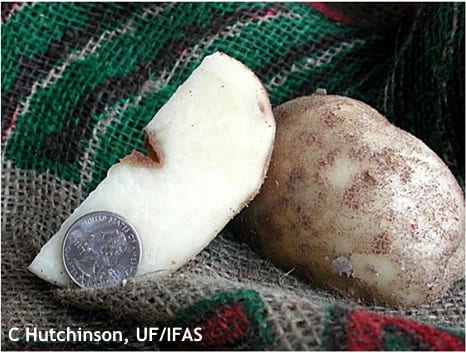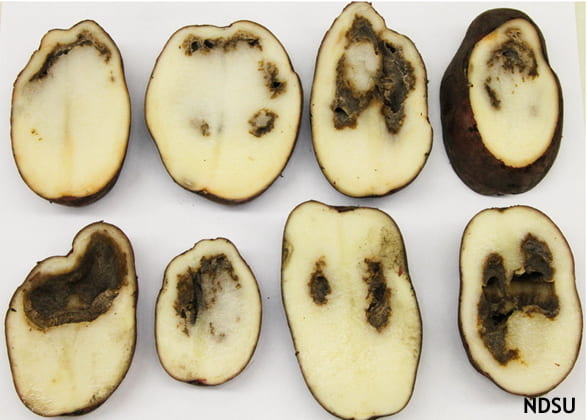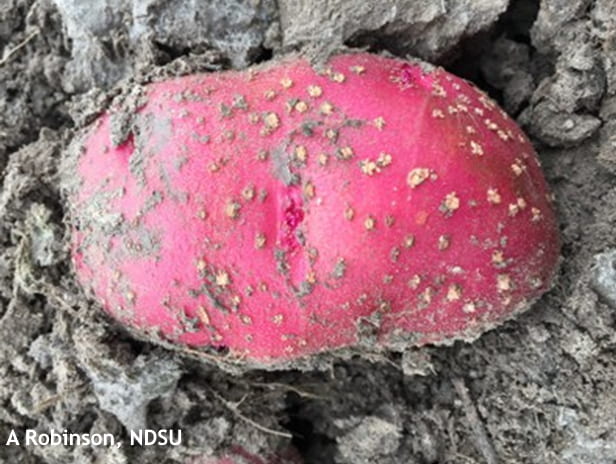Gordon Johnson, Extension Vegetable & Fruit Specialist; gcjohn@udel.edu
Potato harvest will begin soon on Delmarva. There are several physiological disorders affecting potatoes prior to harvest that can be problematic, reducing quality, and causing losses.
Brown Center and Hollow Heart
Brown center and hollow heart are internal noninfectious physiological disorders of the potato tuber. Brown center is characterized by a region of cell death in the pith of the tuber that results in brown tissue. Hollow heart is characterized by a star-shaped hollow in the center of the tuber.
Brown center and hollow heart arise at a higher incidence when growing conditions abruptly change during the season, such as when potato plants recover too quickly after a period of environmental or nutritional stress. When the tubers begin to grow rapidly, the tuber pith can die and/or pull apart, leaving a void in the center. Brown center and hollow heart effects likely form during tuber initiation but could also form during tuber bulking. If the disorder occurs during the early part of the season, then it is most often preceded by brown center and forms in the stem-end of the tuber, while late-forming hollow heart usually occurs near the bud-end with no brown center symptoms occurring.
Internal Heat Necrosis
IHN is described as a physiological disorder caused by elevated soil temperatures during the latter stages of tuber growth and development. IHN is most common in sandy soils. It can be especially severe and symptoms can worsen as the growing season progresses. Tubers growing near the soil surface may experience high temperatures before vine death or harvest and thus are very susceptible to development of the disorder. If the vines and leaves are still actively growing and green during this period of elevated temperatures, water and nutrients are translocated out of the tuber to supply the plant. This mass export of water and nutrients stresses the vascular system within the tuber tissue until the vascular ring eventually deteriorates and becomes necrotic. This results in the browning of the internal tuber tissue.
Low levels of calcium may also play an important role in IHN occurrence. Several studies have found a link between reduced calcium levels in tubers and increased IHN incidence. Calcium is transported to the tubers through the phloem while leaves receive it through the xylem. The xylem is the primary transport pathway for calcium in the plant. Therefore, the calcium content is often higher in leaves compared to tubers, thus possibly contributing to IHN development. Reduced soil moisture could also play a role in IHN occurrence as it would decrease the plant’s overall water use, thus restricting calcium transport.
Wet Soil Disorders: Blackheart and Swollen Lenticels
Blackheart appears as an internal browning to blacking of center tissue. Usually, there is no cavity. Pattern is irregular but margins are well defined. Affected tissue is firm, not soft as with leak, but, when temperature is greater than 65 °F, it may turn soft and inky. There is no odor as with leak.
Any pre-harvest condition that prevents oxygen from reaching the tuber center will result in blackheart. These conditions are commonly waterlogging and long exposure to high field temperatures (>90 °F) before harvest.
Lenticel spot is a common physiological disorder that occurs when lenticels enlarge. Potato tubers are living organisms, so when they are unable to obtain sufficient oxygen, the lenticels enlarge to acquire more oxygen. When soil is waterlogged for a period of time, the lenticels become enlarged and they can appear to be like small white “popcorn” on the tuber surface. When the enlarged lenticels dry, they may appear as small scab lesions.
Lenticel spot not only is unsightly; it also may allow pathogen entry when lenticels are enlarged. This can lead to pathogen infection in and around the lenticels. Research has focused on bacterial soft rot (Pectobacterium carotovora) accumulation in lenticels, most likely because it is the most common pathogen found within the lenticels. Lenticels have been reported to provide an entry point for other pathogens of potato tubers, such as Dickeya species, powdery scab (Spongospora subterranea), late blight (Phytophthora infestans), pythium leak (Pythium ultimum), pink rot (Phytophthora erythroseptica) and common scab (Streptomyces scabies).
Tubers being moved from the field to a packaging facility likely will encounter changes in temperature, moisture levels and air quality that may encourage lenticels to open and bacteria to multiply. In a wet year, many harvested potatoes are likely to have lenticel spot. To mitigate problems with lenticel spot, avoid harvesting low areas in the field.
This information was adapted from:




